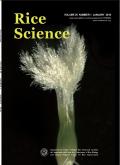Next Generation Nutrition: Genomic and Molecular Breeding Innovations for Iron and Zinc Biofortification in Rice
IF 6.1
2区 农林科学
Q1 AGRONOMY
引用次数: 0
Abstract
Global efforts to address malnutrition and hidden hunger, particularly prevalent in low- and middle-income countries, have intensified, with a focus on enhancing the nutritional content of staple crops like rice. Despite serving as a staple for over half of the world’s population, rice falls short in meeting daily nutritional requirements, especially for iron (Fe) and zinc (Zn). Genetic resources, such as wild rice species and specific rice varieties, offer promising avenues for enhancing Fe and Zn content. Additionally, molecular breeding approaches have identified key genes and loci associated with Fe and Zn accumulation in rice grains. This review explores the genetic resources and molecular mechanisms underlying Fe and Zn accumulation in rice grains. The functional genomics involved in Fe uptake, transport, and distribution in rice plants have revealed key genes such as OsFRO1, OsIRT1, and OsNAS3. Similarly, genes associated with Zn uptake and translocation, including OsZIP11 and OsNRAMP1, have been identified. Transgenic approaches, leveraging transporter gene families and genome editing technologies, offer promising avenues for enhancing Fe and Zn content in rice grains. Moreover, strategies for reducing phytic acid (PA) content, a known inhibitor of mineral bioavailability, have been explored, including the identification of low-PA mutants and natural variants. The integration of genomic information, including whole-genome resequencing and pan-genome analyses, provides valuable insights into the genetic basis of micronutrient traits and facilitates targeted breeding efforts. Functional genomics studies have elucidated the molecular mechanisms underlying Fe uptake and translocation in rice. Furthermore, transgenic and genome editing techniques have shown promise in enhancing Fe and Zn content in rice grains through the manipulation of key transporter genes. Overall, the integration of multi-omics approaches holds significant promise for addressing global malnutrition and hidden hunger by enhancing the nutritional quality of rice, thereby contributing to improved food and nutritional security worldwide.
下一代营养:水稻铁锌生物强化的基因组与分子育种创新
全球正在加紧努力解决营养不良和隐性饥饿问题,尤其是中低收入国家普遍存在的问题,重点是提高大米等主食作物的营养成分。尽管大米是世界上一半以上人口的主食,但仍无法满足日常营养需求,尤其是铁(Fe)和锌(Zn)的需求。野生稻种和特定水稻品种等遗传资源为提高铁和锌的含量提供了前景广阔的途径。此外,分子育种方法已经确定了与水稻谷粒中铁和锌积累相关的关键基因和位点。本综述探讨了水稻籽粒中铁和锌积累的遗传资源和分子机制。参与水稻植株铁吸收、转运和分布的功能基因组学发现了一些关键基因,如 OsFRO1、OsIRT1 和 OsNAS3。同样,与锌的吸收和转运有关的基因,包括 OsZIP11 和 OsNRAMP1,也已被发现。利用转运体基因家族和基因组编辑技术的转基因方法,为提高水稻籽粒中铁和锌的含量提供了前景广阔的途径。此外,还探索了降低植酸(PA)含量的策略,包括鉴定低植酸突变体和天然变体,植酸是已知的矿物质生物利用率抑制剂。基因组信息的整合,包括全基因组重测序和泛基因组分析,为了解微量营养素性状的遗传基础提供了宝贵的见解,并促进了有针对性的育种工作。功能基因组学研究阐明了水稻铁吸收和转运的分子机制。此外,转基因和基因组编辑技术已显示出通过操纵关键转运体基因提高水稻籽粒中铁和锌含量的前景。总之,多组学方法的整合有望通过提高水稻的营养质量来解决全球营养不良和隐性饥饿问题,从而为改善全球粮食和营养安全做出贡献。
本文章由计算机程序翻译,如有差异,请以英文原文为准。
求助全文
约1分钟内获得全文
求助全文
来源期刊

Rice Science
Agricultural and Biological Sciences-Agronomy and Crop Science
CiteScore
8.90
自引率
6.20%
发文量
55
审稿时长
40 weeks
期刊介绍:
Rice Science is an international research journal sponsored by China National Rice Research Institute. It publishes original research papers, review articles, as well as short communications on all aspects of rice sciences in English language. Some of the topics that may be included in each issue are: breeding and genetics, biotechnology, germplasm resources, crop management, pest management, physiology, soil and fertilizer management, ecology, cereal chemistry and post-harvest processing.
 求助内容:
求助内容: 应助结果提醒方式:
应助结果提醒方式:


